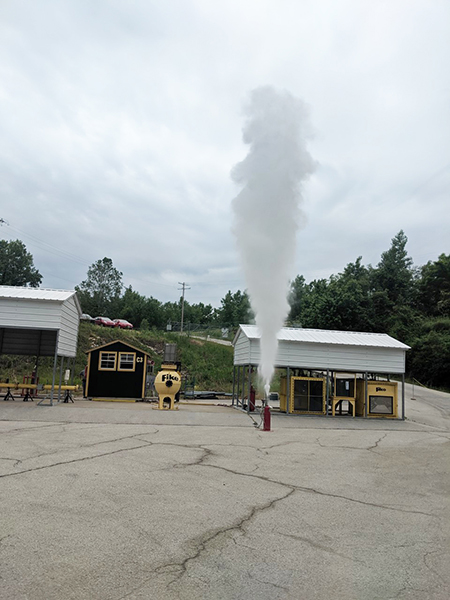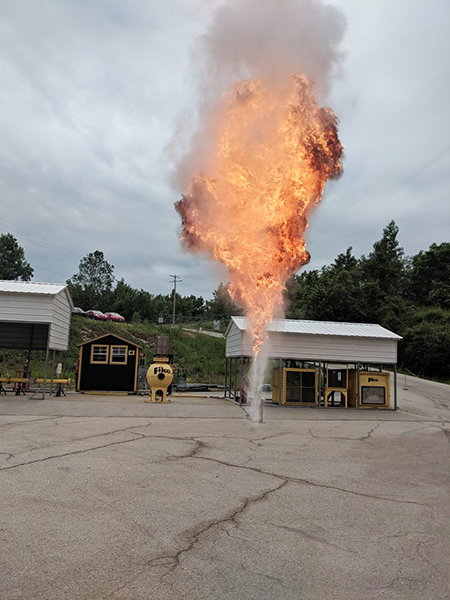
Photos show with and without explosion suppression.
 Deflagration. Ignition. Detonation. Secondary explosion. These sound like words from a war zone, but they actually describe conditions that can develop inside any facility that handles combustible dust. Combustible dust disasters have led to dozens of deaths and injuries in industry and extensive property damage.
Deflagration. Ignition. Detonation. Secondary explosion. These sound like words from a war zone, but they actually describe conditions that can develop inside any facility that handles combustible dust. Combustible dust disasters have led to dozens of deaths and injuries in industry and extensive property damage.
The National Fire Protection Association is working to change that. New standards help owners identify and correct dangerous conditions before accidents occur. While NFPA standards are voluntary, many states or municipalities adopt the NFPA codes, giving them the force of law. At the federal level, current OSHA regulations require almost all industrial plants in the United States to complete Dust Hazard Analysis before Sept. 7, 2020.
Vidimos Inc. of East Chicago, Ind. has installed explosion suppression and/or venting systems in several local plants. “The customers most likely to be interested include those with dust collection systems, such as grain handling facilities,” says Scott Vidimos, president of Vidimos, Inc. Vidimos’s experience is consistent with the extreme risk of dust explosions in grain elevators. In the 1970’s alone, nearly 60 people in the US died in grain dust explosions. “Companies that convey their product pneumatically are also likely candidates. Some companies convey scrap thru ductwork, which raises the potential for explosions.”

Insurance agencies play a pivotal role in having systems installed. “Often, insurance companies initiate the investigation into explosion suppression systems,” Vidimos explains. “Though with current customers, Vidimos may be the first to broach the subject.” Either way, customers work with their insurance companies to ensure that systems are in place to protect people and equipment.
Vidimos partners with Fike, Inc. of Kansas City, Mo., which manufactures proprietary explosion suppression systems. “Fike provides turnkey pricing which includes installation of explosion vents and suppression devices,” Vidimos says. Explosion suppression devices are bottles of various sizes containing a chemical suppressant. “They bring us into the process where we become their labor arm. There are times that the owner is a current customer, but frequently the facility is new to us.”
The geometry and location of the customer’s process dictates which system is best suited for the application. “Fike provides a list of devices along with their locations for us to price installation,” Vidimos says. “To date, most of the installations have been on a single system at a customer’s facility. A typical project would take two men about a week.”
Most of the installations Vidimos performs are on existing systems. Retrofits are the biggest share of the market because so many facilities need protection. In new installations, owners often purchase dust collectors with built-in explosion protection devices. However, even equipment purchased with explosion protection may require skilled modification to accommodate equipment upstream or downstream.
Vidimos designs, fabricates and installs supports for suppression devices. They also fabricate welded duct for dust collectors or cyclones to enable the duct to withstand the initial impulse of an explosion. “Another challenge is to ensure that the devices are located the specified distance from the piece of equipment being protected,” Vidimos says. “We might reroute ductwork to provide the minimum number of elbows and the correct length of straight duct so the devices will operate as intended.”
Fike personnel provide installation training for the specialized equipment while Vidimos project managers are becoming more familiar with the NFPA standards which dictate the process. “Recently, two of our project managers traveled to Fike headquarters in Kansas City, Missouri for orientation and demonstrations,” says Vidimos. High quality workmanship and a commitment to training have placed Vidimos in a strong position to pursue this burgeoning market.